Written by Tingyi Chen – Walk The Chat
As an agency that provides Tmall and social media services, the most common question that comes up throughout operation is: how much money to spend on social media?
I interviewed clients, other brands, agencies, and platforms to conclude with the following trend:
- A higher pricing position means higher spending on social media.
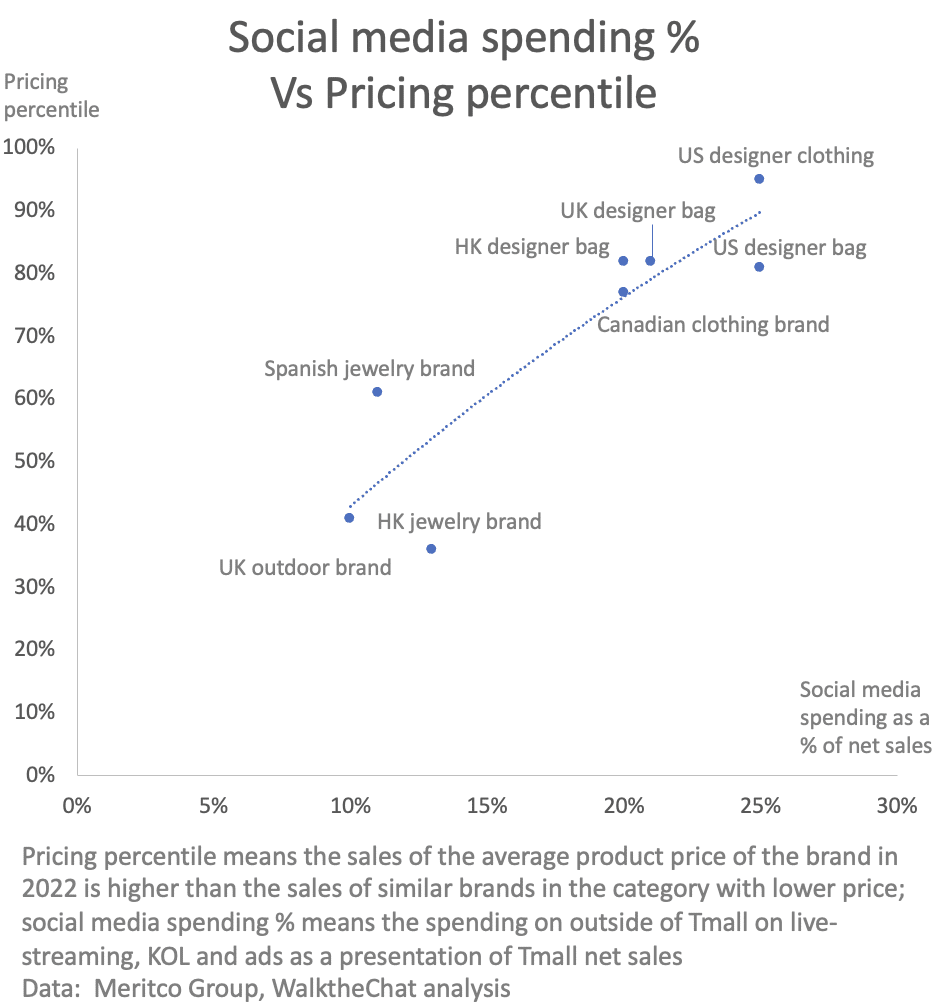
Note the pricing percentile could change a lot based on the Tmall category. For example, the rain boots brand is more expensive compared to 96% of other rain boots but is only in the 41% pricing percentile for outdoor shoes. By competing in the outdoor category in Tmall, the brand gets some pricing advantage which leads to more traffic.
2. The faster the brand wants to grow, the more is needed to spend on social media. Although the coloration between growth rate and social media investment is very weak.

The low collaboration is mainly due to the impact of social media spending on sales varies depending on the goal. For example, we could run an influencer campaign with targeted ads with a 100k RMB budget to get a 400% ROI selling a 600 RMB clothing brand; or we could also run a PR campaign with the same budget and with only limited impact on Tmall sales but the more long-term impact on brand awareness.
In general, we recommend brands spend over 100% of Tmall sales during the first 3 to 6 months of Tmall launch.
According to some agencies, during the first 3 years, the social media spending could even be between 30% to 80% if the brand is aiming for over 10 million RMB Tmall sales and a 3-year breakeven period.
3. Larger brands usually spend less as a percentage on social media marketing.
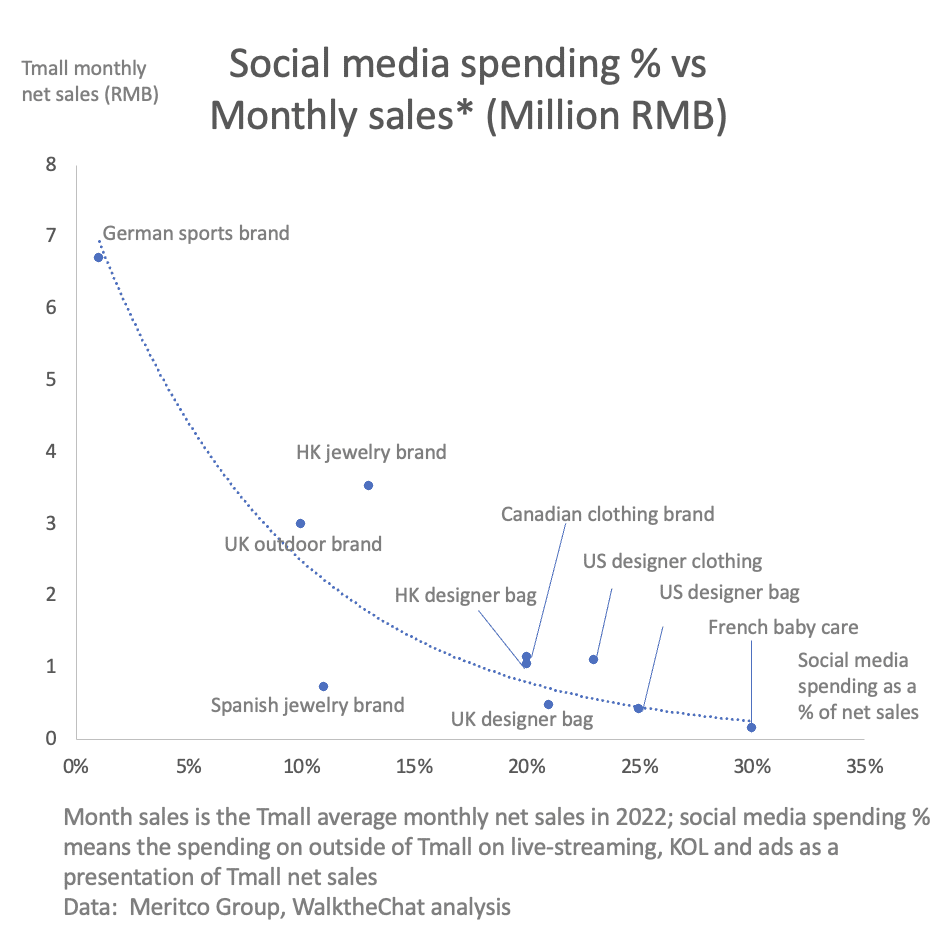
The German sports brand is ranked No.1 in its own Tmall category, thus only spending 1% of its sales on social media marketing. Most new brands need to spend over 20% of their sales on social media marketing when monthly sales are below 1 million RMB.
Categories such as personal care have a much higher margin %, and thus usually have a higher budget to spend on social media; brands with more functional use usually spend less compared with the premium fashion category.
Interviews
How much to spend on social media is a tricky question. We interviewed 10+ brands and 4 Tmall agencies. The answer also varies a lot depending on the brand.
Here are some answers we get.
Ivy Shen, VP of Azoya (Tmall agency)
The % spending on social media and within Tmall depends on the following factors:
- The less brand awareness the brand has in the market, the higher it needs to spend on social media marketing.
- It also depends on the ROAS (return on ad spend)
- How fast and how much brand awareness does the brand need. Brand awareness revenue
Spending as a percentage of Tmall sales can be influenced by the size of the brand:
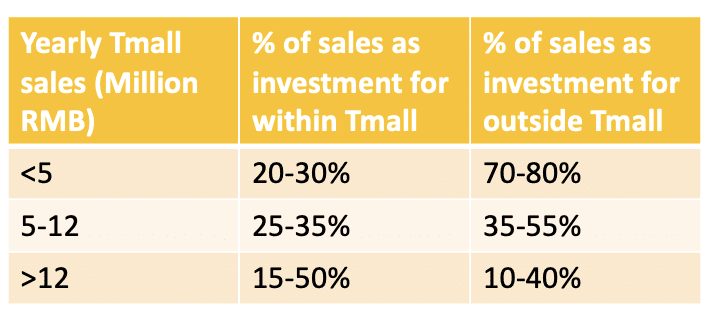
- The brand with 5 million RMB yearly Tmall sales: spend 100% of sales amount on total marketing. 20%-30% goes within Tmall, and 70-80% goes on social media.
- The band with 5-12 million RMB yearly Tmall sales: total marketing spending could be between 60%-90%. 40% of the total budget goes to Tmall, and 60% of the budget goes to social media
- The brand with over 12 million RMB yearly Tmall sales: the marketing budget can be adjusted down to 40%-70%. The amount of social media spending depends on the growth expectation. High growth expectation means more spending on social media. Inside Tmall spending could be 40-70% of the total budget, and social media spending would be 30-60%.
Senior operation manager, Kay Tune (Tmall agency)
Most brands would spend 20% of GMV (gross merchandise value) in social media in the first 3 years…
The % is the balance between profit, GMV, and break-even period…
On the break-even timeline, I worked with 2 kind of brands:
- Willing to wait for 3 years
- Operating in China business as an independent entity. This means the profit and marketing budget is charged to the local entity. The global team is only supporting during the Tmall launch or when sales pick up dramatically. If the China unit has negative EBIT (earning before interest and tax), it will be closed down. A shorter breakeven timeline means lower social media spending and lower sales volume.
Senior operation manager with 10+ years of experience from Kay Tune (a TP agency)
A formal senior account manager from WPIC (Tmall agency)
For mother & baby product that has enough budget, usually we would split budget between Tmall and Social media in a 3:1 ratio…
Since COVID, more brands are expecting breakeven during the 1st year, which it’s not always realistic…
The month before any larger Tmall holidays, we suggest brand to invest 100% of GMV into social media marketing.
For fashion brand, most of social media spending is on Red; for brand with more functionality, Bilibili is the major spending channel since review videos performance well for sales.
A formal senior account manager from WPIC (a TP agency)
Marimekko
A Finnish lifestyle brand with an average product price of around 2400 RMB.
2022 marketing investment within Tmall: 23% of net sales
2022 marketing investment outside of Tmall: 23% of net sales
% social media spending depends on our gloabl target. During the luanch, we focused on building brand awareness. In total we spend 2.5 million RMB in Tmall in 2022.
We are planning to increase the spending on Tmall for 2023, since the sales target is 2.5X compared to 2022. And the overall marketing strategy is a lot more focused on performance marketing.
Olivia, the marketing manager of Marimekko
Hong Kong premium jewelry brand
A Hong Kong premium jewelry brand with an average product price of 1900 RMB
2022 year-over-year change (YoY)%: 54% increase
Marketing investment: 15%-18% of net sales
2022 marketing investment within Tmall: 5% of net sales
2022 marketing investment outside of Tmall: 13% of net sales
Tmall vs. social spending: 30% vs. 70%
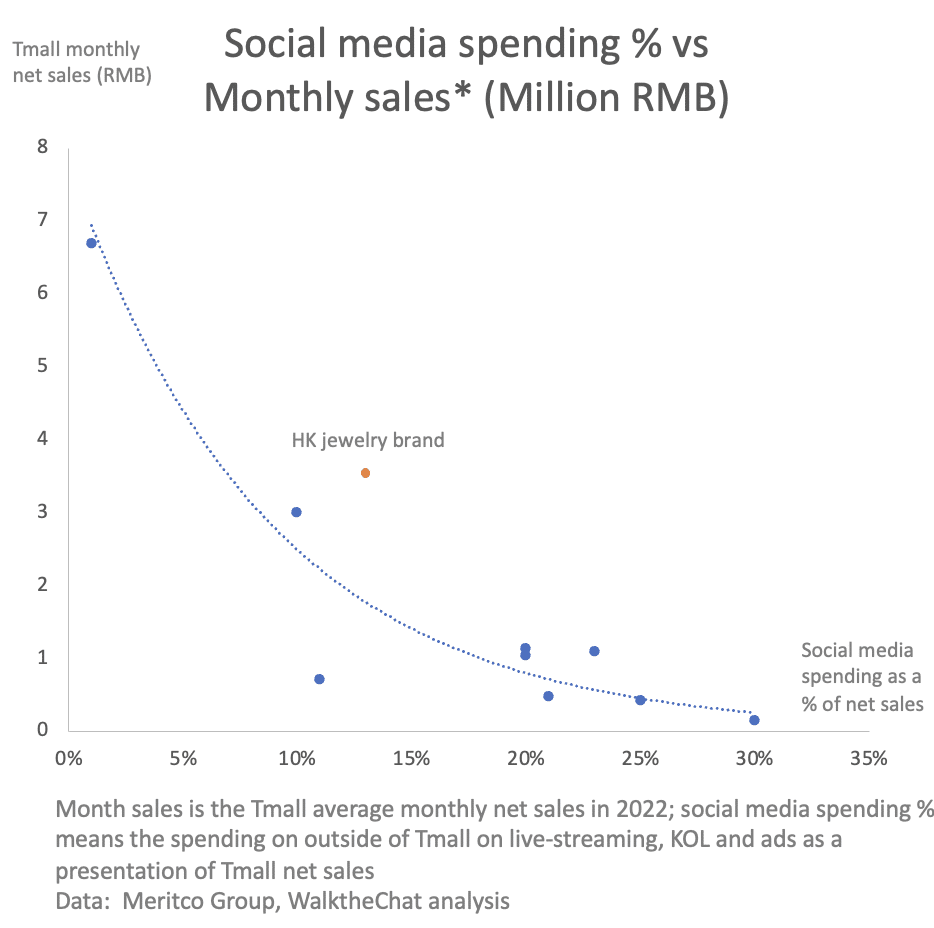
We spend 70% of our marketing budget on social media, mainly on the Little Red Book. Our conversion funnel is longer, thus building brand awareness and trust is the key. Especially for new customer acquisition, conversion is higher if the customer first heard of us from an influencer they trust.
We monitor the add-to-cart cost, so the spending split also largely depends on this.
We spend around 2% of net sales on Tmall for doing various tests. Usually, a new product would have a higher add-to-cart cost, but it will decrease as we spend in marketing, until we saturate the market and it will start to rise again.
-The founder
An iconic UK outdoor brand A
Average product price: 850 RMB
Pricing percentile: more expensive than 41% of outdoor casual shoes
2022 Average monthly net sales: 3.1 million RMB
2022 Tmall net sales: 43 million RMB
2022 year-over-year change (YoY)%: 80% increase
2022 marketing investment within Tmall: 17% of net sales
2022 marketing investment outside of Tmall: 10% of net sales

As the brand’s yearly sales reached over 30 million RMB, the marketing strategy had a complete shift from focusing on sales return to focusing on brand awareness. During the initial growth phase, the brand used to setup KOL target at 200% ROI. Now the brand is large enough to devote budget on celebrity seeding and PR campaigns. Even though the social media marketing budget is kept at 10%, the goal for this budget is nolonger short-term sales conversion, rather on-brand content and celebrity endorcement.
WalktheChat account manager for this brand
Hong Kong premium bag brand
A Hong Kong premium bag brand with an average price of around 3500 RMB
2022 marketing investment within Tmall: 5% of net sales
2022 marketing investment outside of Tmall: 20% of net sales
Tmall spending vs. Social media spending: 3:7
The brand newly launched its Tmall store 3 months ago. The brand took an organic approach to enter China by selling via WeChat cross-border store during the first 2 years. It builds strong momentum via a targeted influencer seeding strategy on the Little Red Book. When the brand finally launched on Tmall during the 3rd year, it already has a strong Tmall search volume and thus it was able to hit over 1 million RMB monthly sales during the first 3 months of Tmall launch.
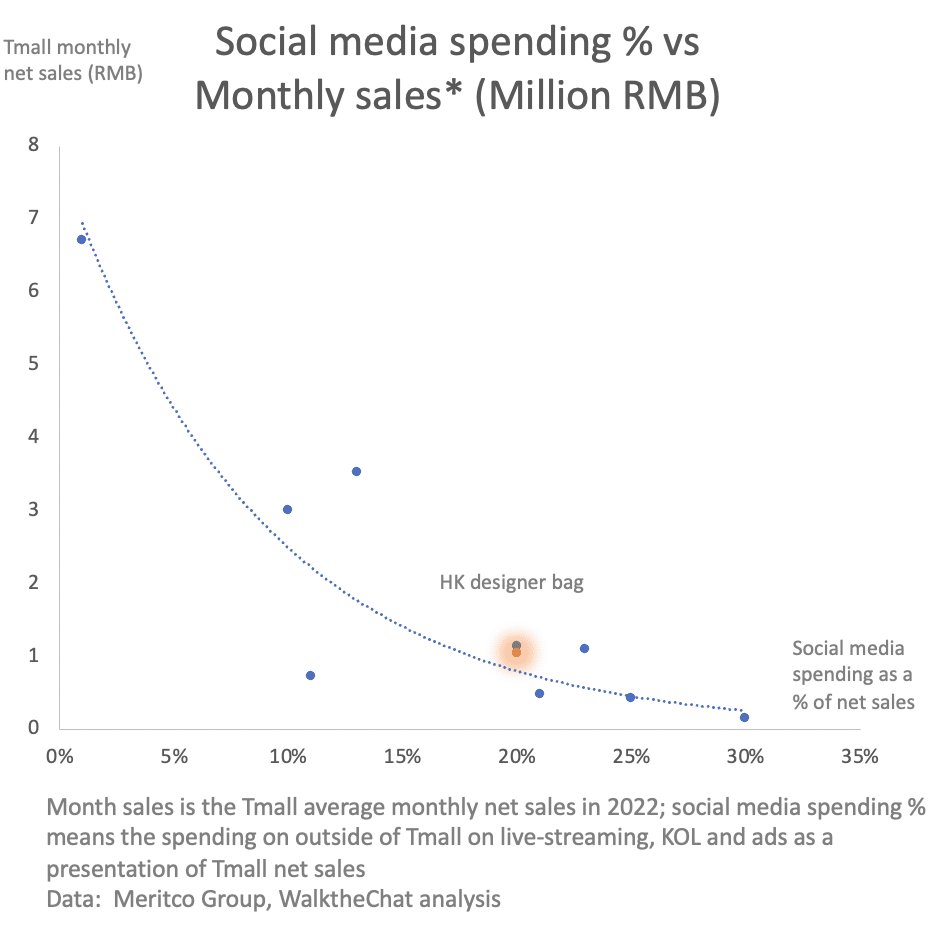
The brand spends around 20% of sales on social media campaigns and seeding. This creates around 50 Red postings per month with a 50-70% of bookmark ratio (bookmark over like). 50 posts from various fashion influencers is a decent amount of promotion to generate sales conversion on Tmall, and the bookmark ratio is a good indicator of the purchase intention of the viewers. On average, a typical premium bag brand usually gets a 30-40% bookmark ratio.
French baby personal care brand
Average product price: 90 RMB
Average monthly sales: 0.2 million RMB
2022 year-over-year change (YoY)%: 48% increase
2022 marketing investment within Tmall: 40% of net sales
2022 marketing investment outside of Tmall: 30% of net sales

The spending on social media is usually much higher as a percentation for personal care brand, it’s an industry with higher margin.
This brand only has 700 Little Red Book mention, with such a low brand awarness, spending 70% of its net sale on marketing is nessessary during the first year of operation. Although for personal care brand, building a strong distribution network is more important than D2C marketing approach.
WalktheChat account manager for this brand
German sports equipment brand
Average product price: 550 RMB
2022 Tmall net sales: 111 million RMB (No. 1 in its category)
2022 year-over-year change (YoY)%: 11% decrease
2022 marketing investment within Tmall: 3% of net sales
2022 marketing investment outside of Tmall: 1% of net sales
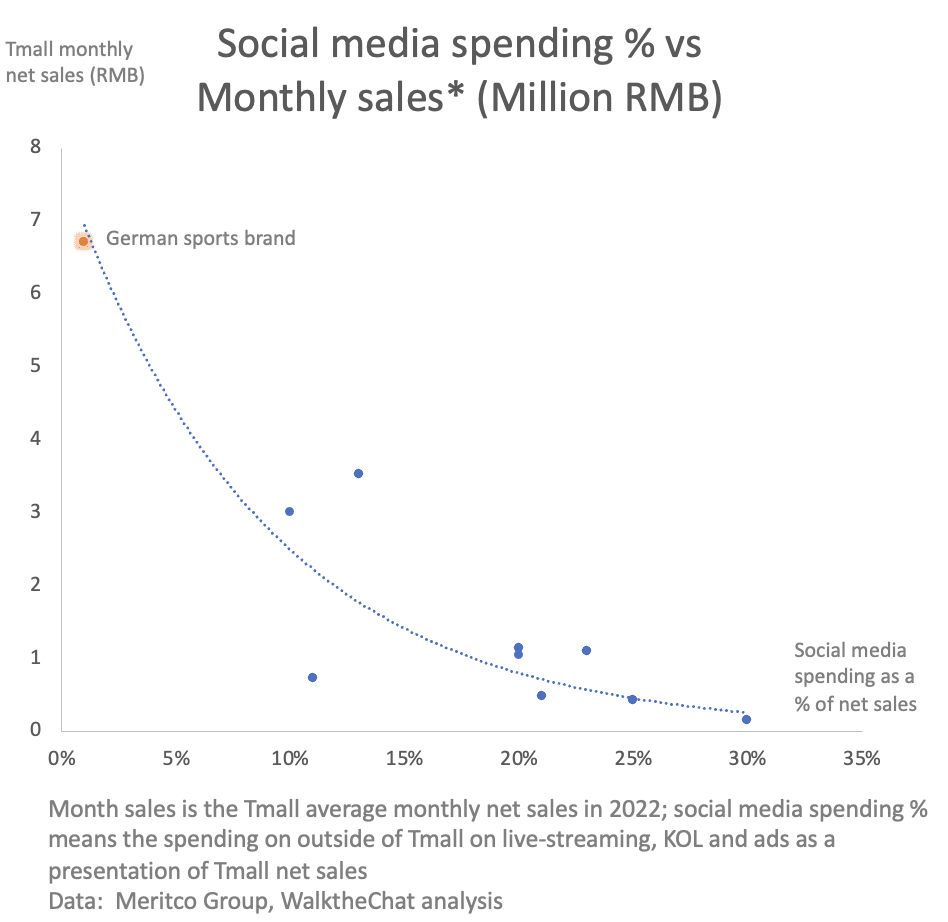
Although the social media marketing spending is only 1%, this is much lower compared to other brands in its category. The major reason for such low investment is:
- It has a strong competitive advantage in material and non of its competitor can replicate
- The major celebrity spending is charged to its global unit, thus not counted here
- The brand has been operating in China for over 10 years and has a 13% market share in its category
WalktheChat account manager for this brand
Conclusion
The spending on social media in China varies a lot. In general, premium position products, faster growth curves, and smaller brands need to spend a larger percentage of their sales on social media marketing. But it’s not a one-size-fits-all, and the spending amount changes over time for each brand. The 3 things brands can do are:
- Closely monitor your competitors
- Keep a clear track of social media spending ROI and compare it to Tmall ads ROI to find an optimal spending split
- Prioritize GMV, profit, and breakeven time. You cannot have them all.
(Source: WalkTheChat.com)
Visit HPA-China’s Information Hub, CLICK HERE
